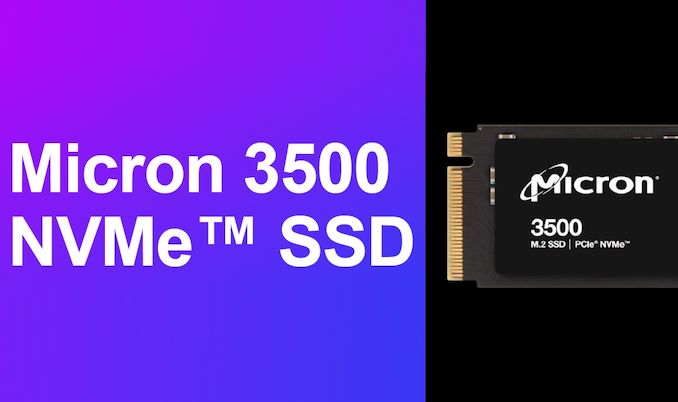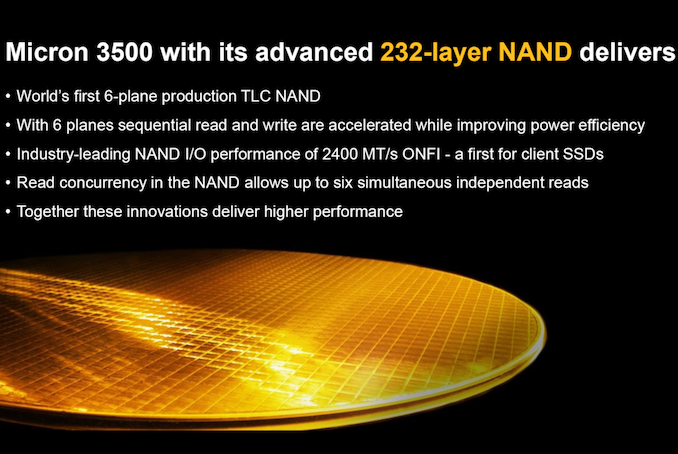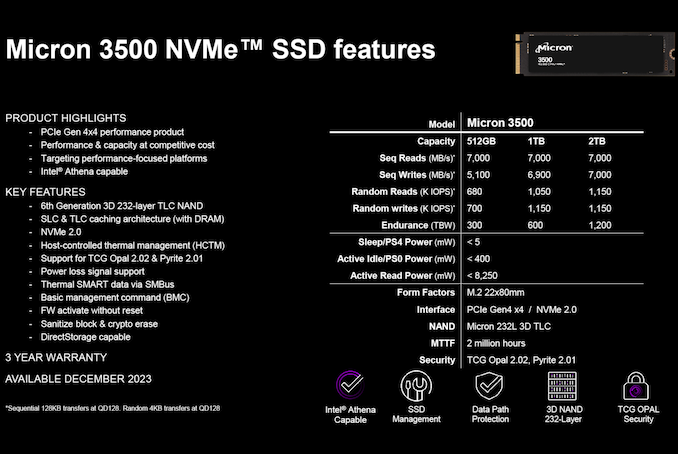Micron has been on a roll lately with new product introductions despite the downturn in the flash market. The company is currently the only NAND manufacturer shipping products based on 200+L 3D TLC in volume. Thanks to the advantage of higher bit density and rapid maturity in yields, Micron has better leeway in pricing and margins compared to its peers. As a result, we have had multiple 232L product launches in the enterprise (Micron 6500 ION), OEM (Micron 2550), and consumer (Crucial T700, Crucial T500) segments over the last year. In addition to higher bit density, the 232L 3D TLC NAND also delivers significant bandwidth improvements with its 6-plane architecture.
Micron is launching the 3500 NVMe SSD series today. It is the first PCIe Gen4 x4 232L 3D TLC NAND OEM drive in the market. Micron develops SSD platforms for client systems and markets them under the Crucial brand name for direct purchase by end-users. The company has also been releasing the same platforms under the Micron brand for OEMs and system integrators. Obviously, the validation cycles and OEM qualification requirements dictate a slightly different approach to the firmware compared to what is put into the Crucial drives. As a result, the advertised specifications may differ slightly for the same hardware platform based on the target market. The 3500 NVMe SSD utilizes the same hardware as the recently-released Crucial T500 - Micron's 232L 3D TLC NAND behind the Phison E25 controller operating in 4-channel mode, with the NAND configured for 2400 MT/s and dedicated DRAM on the drive for the flash translation layer (FTL).
Almost all of the key selling points of the Crucial T500 transfer themselves to the Micron 3500 NVMe SSD. These include class-leading bandwidth numbers saturating the Gen4 links and DirectStorage support. The peak reads are at 7 GBps instead of 7.4 GBps, but that is due to the nature of the systems dictated by OEM qualification requirements. Endurance numbers are the same as the T500's, but the warranty period is only 3 years (compared to the T500's 5 years). This actually translates to a higher DWPD rating for the drive, and is a typical demand of the OEMs who qualify these drives for use in their systems. The SSD's power consumption numbers and wake times from sleep are also geared for Intel's Project Athena certification - an aspect that is important for OEMs delivering high-performance notebooks. The target market for the 3500 NVMe SSD is high-end workstations and gaming systems. As a result, Micron's marketing numbers have focused on benchmarks such as SPECwpc storage (part of the SPECworkstation suite). We are looking forward to confirming the claims with our own hands-on evaluation in the near future.
The launch of the Micron 3500 NVMe SSD has enabled the company to cater to the entire range of OEM client systems requiring Gen4 NVMe drives. The entry-level Micron 2400 series with 176L QLC NAND is meant for the cost-sensitive market, while the Micron 2550 moves to 232L 3D TLC with the previous-generation Phison controller. Both drive families are available in multiple M.2 form-factors. The 3500 NVMe SSD fills up the flagship role. With high-end computing systems being the target, the drive will be available only in the M.2 2280 form-factor. It is surprising that a 4TB drive is not available at launch, given that high-end systems are typically hungry for storage capacity. Hopefully, that is a hole in the product stack that Micron will be able to fill in both the Crucial T700 and Micron 3500 NVMe SSD families sometime next year.




0 Comments